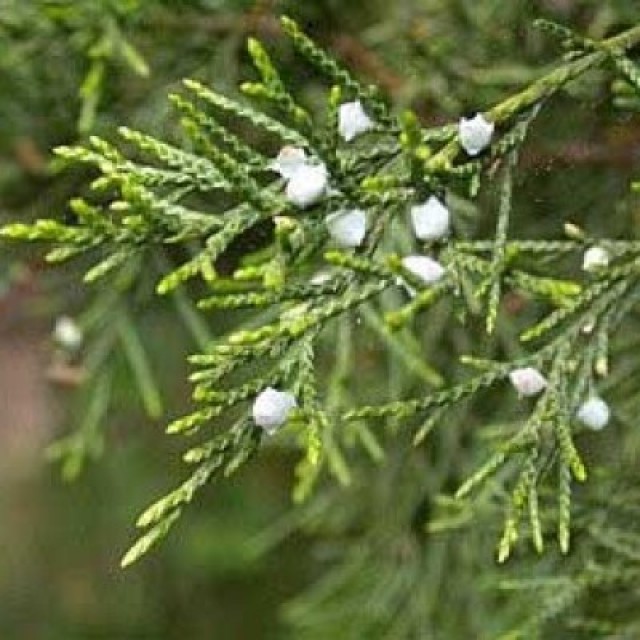COMMON NAME
Eastern redcedar
SCIENTIFIC NAME
Juniperus virginiana
ALSO KNOWN AS
red cedar, Virginian juniper, eastern juniper, red juniper
Plant family
Cypress (Cupressaceae)
Plant group
Conifers
Juniperus virginiana is a small to mid-sized coniferous evergreen tree that lives for hundreds of years and is native to eastern North America.
317 reports
134+
OBSERVERS
317+
OBSERVATIONS
Identification hints
Juniperus virginiana can range from the size of a bush up to 90 feet tall, generally looks like an conical to columnar evergreen tree with trunks on average 20 inches in diameter. Older plants produce leaves that last for 6 years and are small, waxy, green, and scale-like. The seed cones look like purple berries, the bark is red, and the plant is generally aromatic.
Did you know?
Many birds and mammals eat the berry-like cones of redcedar, especially in winter, including solitaires, grouse, waxwings, quail, rabbits, foxes, and raccoons. The aromatic oils in redcedar are effective in repelling clothing moths, and are used in perfumes. Redcedar mulch can be used to repel ants. Heartwood of redcedar is quite resistant to decay and is used in fence posts, poles, closets, chests and pencils. There are several unrelated species that are also called cedar including western redcedar (Thuja), and members of the pine family (Cedrus).
DISTRIBUTION IN TH U.S.
Alabama
,
Arkansas
,
Colorado
,
Connecticut
,
Delaware
,
Florida
,
Georgia
,
Iowa
,
Illinois
,
Indiana
,
Kansas
,
Kentucky
,
Louisiana
,
Massachusetts
,
Maryland
,
Maine
,
Michigan
,
Minnesota
,
Missouri
,
Mississippi
,
North Carolina
,
North Dakota
,
Nebraska
,
New Hampshire
,
New Jersey
,
New York
,
Ohio
,
Oklahoma
,
Oregon
,
Pennsylvania
,
Rhode Island
,
South Carolina
,
South Dakota
,
Tennessee
,
Texas
,
Virginia
,
Vermont
,
Wisconsin
,
West Virginia
HABITAT
Found in a wide range of soils and growing conditions, from swamps to dry, rocky glades and in many types of forest including red and white oak, hickory and mixed pine-hardwood forests. It can also occur in prairies, and may form cedar glades. Eastern redcedar can tolerate many soil types including dry, limestone soils, sandy, medium loam, clay, and rocky.
ATTRIBUTES
Leaves
The leaves are found in two forms. On seedlings and new twigs, leaves are pointed and awl-shaped, 0.25 to 0.5 in (0.64 to 1.3 cm) long. On mature branches, closely overlapping scale-like leaves 0.063 to 0.13 in (1.6 to 3.3 mm) in length fit tightly against the twig in opposite pairs. The leaves are dark green; sometimes turning reddish brown in winter. The stem is single with upright or spreading branches.
Pollen Cones
Pollen cones and seed cones are usually on separate trees, although some trees are monoecious. Pollen cones are yellowish-brown with yellow pollen, oval to egg-shaped, papery single cones found at the tips of the two-year old branches.
Seed Cones
Immature seed cones are light blue-green, inconspicuous and found in large bunches at the tips of short branches. Mature seed cones are round, with a waxy pale-blue to blackish-green color. Berry-like cones are a quarter-inch in diameter. One to three yellow-brown, round seeds occur in each berry-like seed cone. The seeds are very small, ridged near the base, and sometimes shallowly pitted. The seeds don't come out of the cone until animal interference.
Bark
The bark is reddish-brown, fibrous, and peels off in narrow strips. The bark is used in cedar essential oils because of its chemical properties.
Bloom Time
Eastern redcedar begins releasing pollen in February in the south or as late as May in the north and west.
See Menu
- 2021 Chicago Botanic Garden. All Rights Reserved.
-
Creative Commons
BY-NC-SA 4.0 - Terms of Use
- Privacy Policy
- Data Sharing and Citation Policies
- 2021 Chicago Botanic Garden. All Rights Reserved.



